13.2 Transcription Is the Synthesis of an RNA Molecule from a DNA Template
All cellular RNAs are synthesized from DNA templates through the process of transcription (Figure 13.2). Transcription is in many ways similar to the process of replication, but a fundamental difference relates to the length of the template used. In replication, all the nucleotides in the DNA template are copied, but, in transcription, only small parts of the DNA molecule—usually a single gene or, at most, a few genes—are transcribed into RNA. Because not all gene products are needed at the same time or in the same cell, the constant transcription of all of a cell’s genes would be highly inefficient. Furthermore, much of the DNA does not encode a functional product, and transcription of such sequences would be pointless. Transcription is, in fact, a highly selective process: individual genes are transcribed only as their products are needed. However, this selectivity imposes a fundamental problem on the cell—how to recognize individual genes and transcribe them at the proper time and place.
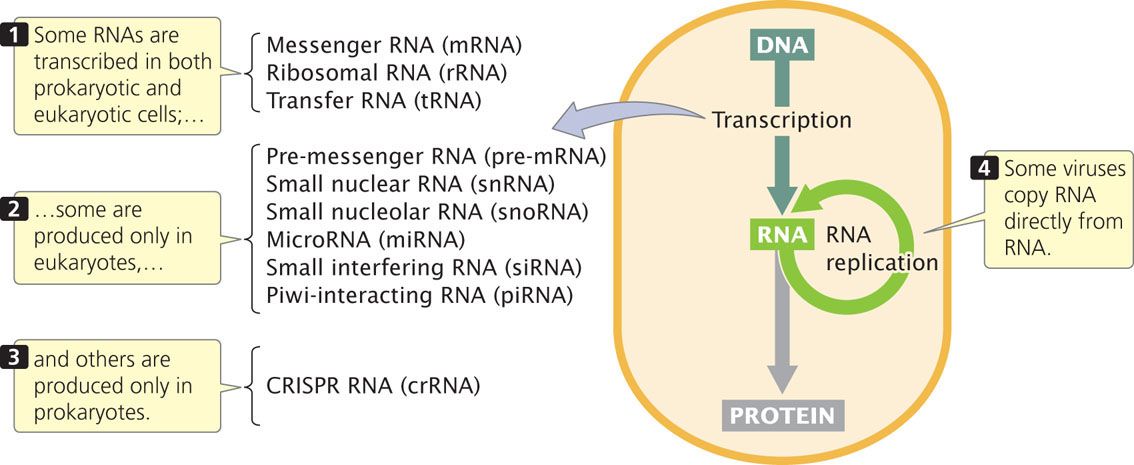
361
Like replication, transcription requires three major components:
- 1. a DNA template;
- 2. the raw materials (ribonucleotide triphosphates) needed to build a new RNA molecule; and
- 3. the transcription apparatus, consisting of the proteins necessary for catalyzing the synthesis of RNA.
The Template
In 1970, Oscar Miller, Jr., Barbara Hamkalo, and Charles Thomas used electron microscopy to examine cellular contents and demonstrate that RNA is transcribed from a DNA template. They saw Christmas-tree-like structures within the cell: thin central fibers (the trunk of the tree), to which were attached strings (the branches) with granules (Figure 13.3a). The addition of deoxyribonuclease (an enzyme that degrades DNA) caused the central fibers to disappear, indicating that the “tree trunks” were DNA molecules. Ribonuclease (an enzyme that degrades RNA) removed the granular strings, indicating that the branches were RNA. Their conclusion was that each “Christmas tree” represented a gene undergoing transcription (Figure 13.3b). The transcription of each gene begins at the top of the tree; there, little of the DNA has been transcribed and the RNA branches are short. As the transcription apparatus moves down the tree, transcribing more of the template, the RNA molecules lengthen, producing the long branches at the bottom.
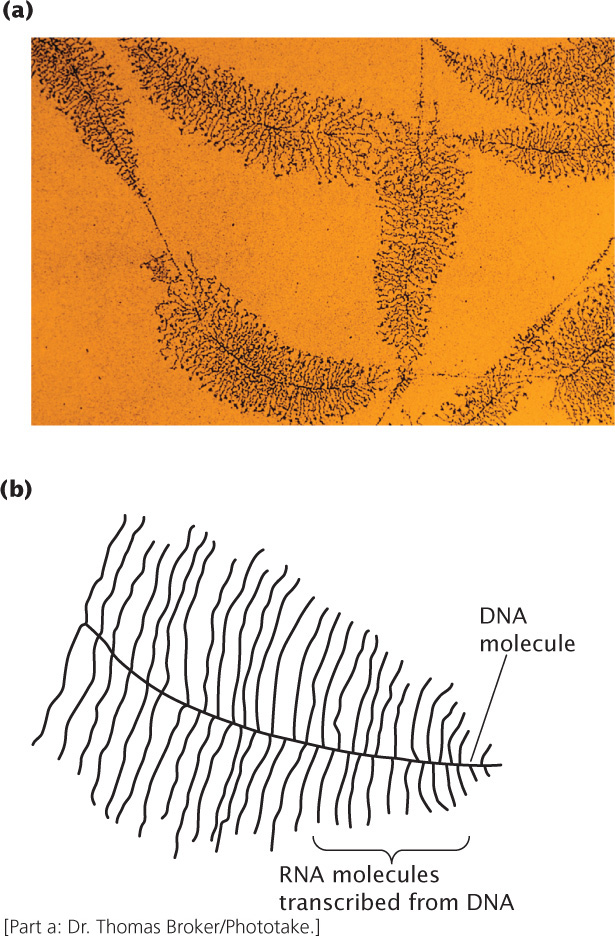
362
The Transcribed Strand
The template for RNA synthesis, as for DNA synthesis, is a single strand of the DNA double helix. Unlike replication, however, the transcription of a gene takes place on only one of the two nucleotide strands of DNA (Figure 13.4). The nucleotide strand used for transcription is termed the template strand. The other strand, called the nontemplate strand, is not ordinarily transcribed. Thus, within a gene, only one of the nucleotide strands is normally transcribed into RNA (there are some exceptions to this rule).

During transcription, an RNA molecule that is complementary and antiparallel to the DNA template strand is synthesized (see Figure 13.4). The RNA transcript has the same polarity and base sequence as that of the nontemplate strand, with the exception that RNA contains U rather than T. In most organisms, each gene is transcribed from a single strand, but different genes may be transcribed from different strands, as shown in Figure 13.5.  TRY PROBLEM 15
TRY PROBLEM 15

CONCEPTS
Within a single gene, only one of the two DNA strands, the template strand, is usually transcribed into RNA.
 CONCEPT CHECK 2
CONCEPT CHECK 2
What is the difference between the template strand and the nontemplate strand?
The Transcription Unit
A transcription unit is a stretch of DNA that encodes an RNA molecule and the sequences necessary for its transcription. How does the complex of enzymes and proteins that performs transcription—the transcription apparatus—recognize a transcription unit? How does it know which DNA strand to read and where to start and stop? This information is encoded by the DNA sequence.
Included within a transcription unit are three critical regions: a promoter, an RNA-coding sequence, and a terminator (Figure 13.6). The promoter is a DNA sequence that the transcription apparatus recognizes and binds. It indicates which of the two DNA strands is to be read as the template and the direction of transcription. The promoter also determines the transcription start site, the first nucleotide that will be transcribed into RNA. In many transcription units, the promoter is located next to the transcription start site but is not, itself, transcribed.

The second critical region of the transcription unit is the RNA-coding region, a sequence of DNA nucleotides that is copied into an RNA molecule. The third component of the transcription unit is the terminator, a sequence of nucleotides that signals where transcription is to end. Terminators are usually part of the RNA-coding sequence; transcription stops only after the terminator has been copied into RNA.
363
Molecular biologists often use the terms upstream and downstream to refer to the direction of transcription and the location of nucleotide sequences surrounding the RNA-coding sequence. The transcription apparatus is said to move downstream during transcription: it binds to the promoter (which is usually upstream of the start site) and moves toward the terminator (which is downstream of the start site).
When DNA sequences are written out, often the sequence of only one of the two strands is listed. Molecular biologists typically write the sequence of the nontemplate strand, because it will be the same as the sequence of the RNA transcribed from the template (with the exception that U in RNA replaces T in DNA). By convention, the sequence on the nontemplate strand is written with the 5′ end on the left and the 3′ end on the right. The first nucleotide transcribed (the transcription start site) is numbered +1; nucleotides downstream of the start site are assigned positive numbers, and nucleotides upstream of the start site are assigned negative numbers. So, nucleotide +34 would be 34 nucleotides downstream of the start site, whereas nucleotide −75 would be 75 nucleotides upstream of the start site. There is no nucleotide numbered 0.
CONCEPTS
A transcription unit is a piece of DNA that encodes an RNA molecule and the sequences necessary for its proper transcription. Each transcription unit includes a promoter, an RNA-coding region, and a terminator.
 CONCEPT CHECK 3
CONCEPT CHECK 3
Which of the following phrases does not describe a function of the promoter?
- Serves as sequence to which transcription apparatus binds
- Determines the first nucleotide that is transcribed into RNA
- Determines which DNA strand is template
- Signals where transcription ends
The Substrate for Transcription
RNA is synthesized from ribonucleoside triphosphates (rNTPs; Figure 13.7). In synthesis, nucleotides are added one at a time to the 3′-OH group of the growing RNA molecule.
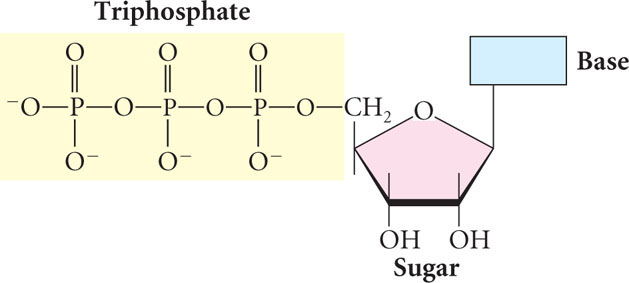
Two phosphate groups are cleaved from the incoming ribonucleoside triphosphate; the remaining phosphate group participates in a phosphodiester bond that connects the nucleotide to the growing RNA molecule. The overall chemical reaction for the addition of each nucleotide is
RNAn + rNTP → RNAn+1 + PPi
where PPi represents pyrophosphate. Nucleotides are always added to the 3′ end of the RNA molecule, and the direction of transcription is therefore 5′→3′ (Figure 13.8), the same as the direction of DNA synthesis during replication. The synthesis of RNA is complementary and antiparallel to one of the DNA strands (the template strand). Unlike DNA synthesis, RNA synthesis does not require a primer.
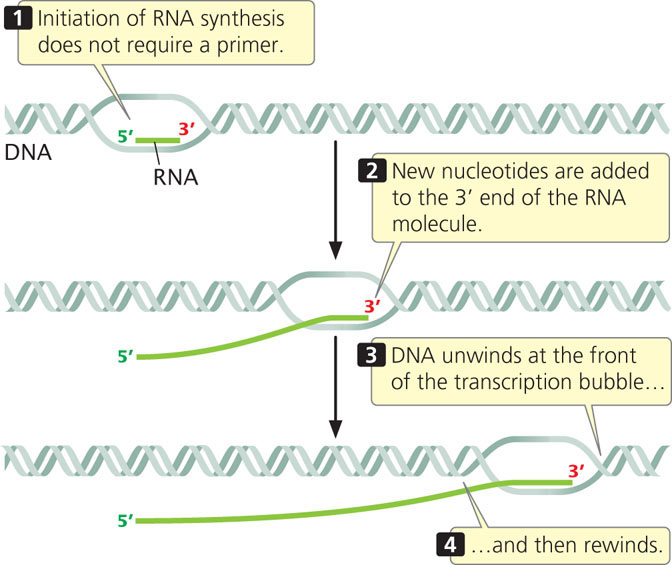
CONCEPTS
RNA is synthesized from ribonucleoside triphosphates. Transcription is 5′→3′: each new nucleotide is joined to the 3′-OH group of the last nucleotide added to the growing RNA molecule.
The Transcription Apparatus
Recall that DNA replication requires a number of different enzymes and proteins. Although transcription might initially appear to be quite different because a single enzyme—RNA polymerase—carries out all the required steps of transcription, on closer inspection, the processes are actually similar. The action of RNA polymerase is enhanced by a number of accessory proteins that join and leave the polymerase at different stages of the process. Each accessory protein is responsible for providing or regulating a special function. Thus, transcription, like replication, requires an array of proteins.
364
Bacterial RNA Polymerase
Bacterial cells typically possess only one type of RNA polymerase, which catalyzes the synthesis of all classes of bacterial RNA: mRNA, tRNA, and rRNA. Bacterial RNA polymerase is a large, multimeric enzyme (meaning that it consists of several polypeptide chains).
At the heart of most bacterial RNA polymerases are five subunits (individual polypeptide chains) that make up the core enzyme: two copies of a subunit called alpha (α) and single copies of subunits beta (β), beta prime (β′), and omega (ω) (Figure 13.9). The ω subunit is not essential for transcription, but it helps stabilize the enzyme. The core enzyme catalyzes the elongation of the RNA molecule by the addition of RNA nucleotides. Other functional subunits join and leave the core enzyme at particular stages of the transcription process. The sigma (σ) factor controls the binding of RNA polymerase to the promoter. Without sigma, RNA polymerase will initiate transcription at a random point along the DNA. After sigma has associated with the core enzyme (forming a holoenzyme), RNA polymerase binds stably only to the promoter region and initiates transcription at the proper start site. Sigma is required only for promoter binding and initiation; when a few RNA nucleotides have been joined together, sigma usually detaches from the core enzyme. Many bacteria have multiple types of sigma factors; each type of sigma initiates the binding of RNA polymerase to a particular set of promoters.
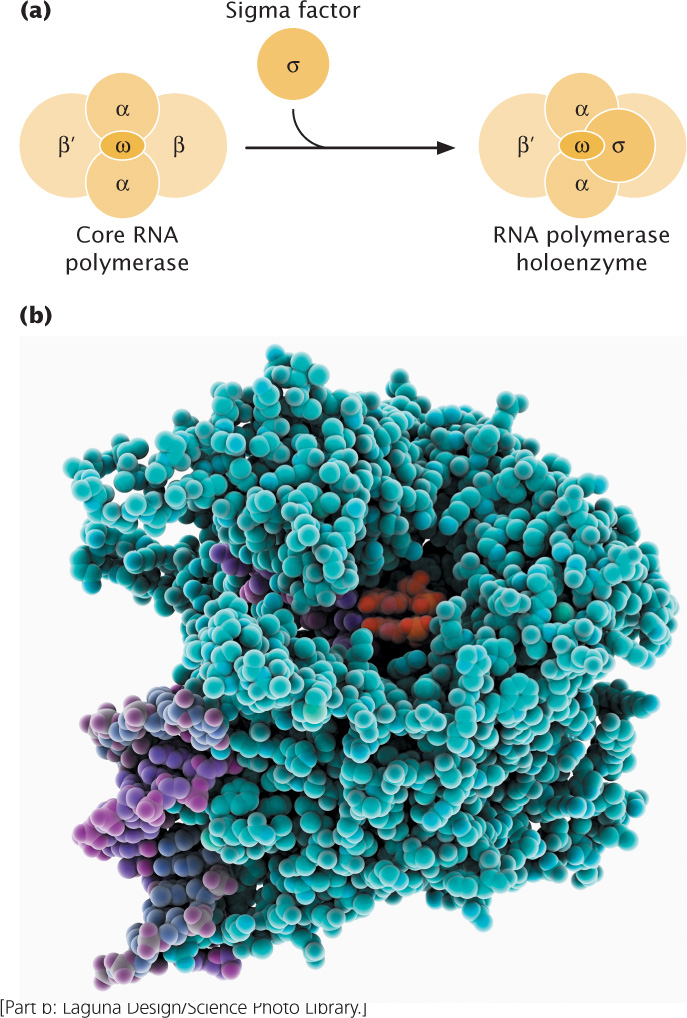
Rifamycins are a group of antibiotics that kill bacterial cells by inhibiting RNA polymerase. These antibiotics are widely used to treat tuberculosis, a disease that kills almost 2 million people worldwide each year. The structures of bacterial and eukaryotic RNA polymerases are sufficiently different that rifamycins inhibit bacterial RNA polymerases without interferring with eukaryotic RNA polymerases. Recent research has demonstrated that several rifamycins inibit RNA polymerase by binding to the part of the RNA polymerase that clamps on to DNA and jamming it, thus preventing the RNA polymerase from interacting with the promoter on the DNA.
Eukaryotic RNA Polymerases
Most eukaryotic cells possess three distinct types of RNA polymerase, each of which is responsible for transcribing a different class of RNA: RNA polymerase I transcribes rRNA; RNA polymerase II transcribes pre-mRNAs, snoRNAs, some miRNAs, and some snRNAs; and RNA polymerase III transcribes other small RNA molecules—specifically tRNAs, small rRNA, some miRNAs, and some snRNAs (Table 13.3). RNA polymerases I, II, and III are found in all eukaryotes. Two additional RNA polymerases, RNA polymerase IV and RNA polymerase V, have been found in plants. RNA polymerases IV and V transcribe RNAs that play a role in DNA methylation and chromatin structure.
| Type | Present in | Transcribes |
|---|---|---|
| RNA polymerase I | All eukaryotes | Large rRNAs |
| RNA polymerase II | All eukaryotes | Pre-mRNA, some snRNAs, snorNas, some miRNAs |
| RNA polymerase III | All eukaryotes | tRNAs, small rRNAs, some snRNAs, some miRNAs |
| RNA polymerase IV | Plants | Some siRNAs |
| RNA polymerase V | plants | RNA molecules taking part in heterochromatin formation |
365
All eukaryotic polymerases are large, multimeric enzymes, typically consisting of more than a dozen subunits. Some subunits are common to all RNA polymerases, whereas others are limited to one of the polymerases. As in bacterial cells, a number of accessory proteins bind to the core enzyme and affect its function.
CONCEPTS
Bacterial cells possess a single type of RNA polymerase, consisting of a core enzyme and other subunits that participate in various stages of transcription. Eukaryotic cells possess several distinct types of RNA polymerase that transcribe different kinds of RNA molecules.
 CONCEPT CHECK 4
CONCEPT CHECK 4
What is the function of the sigma factor?